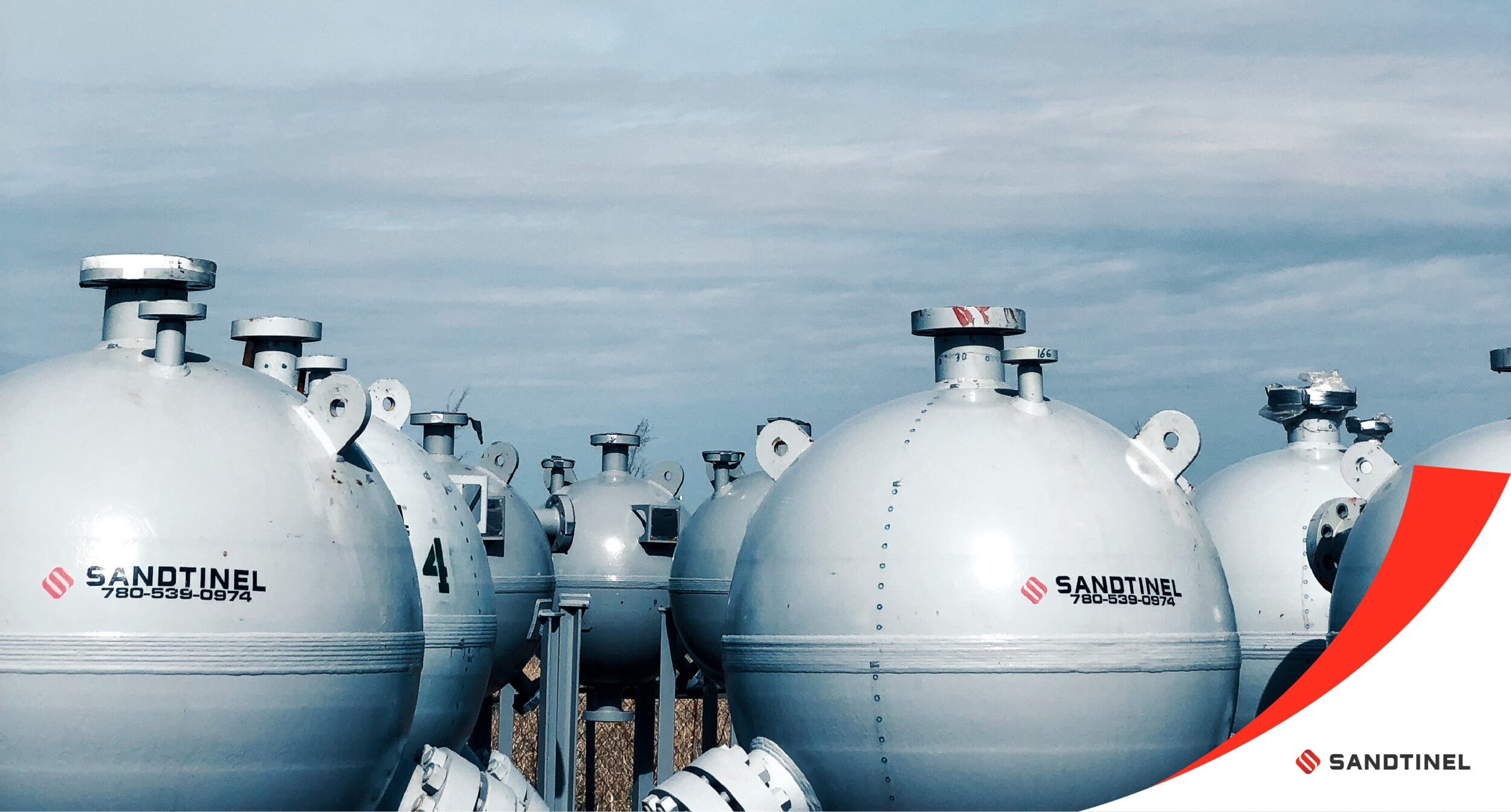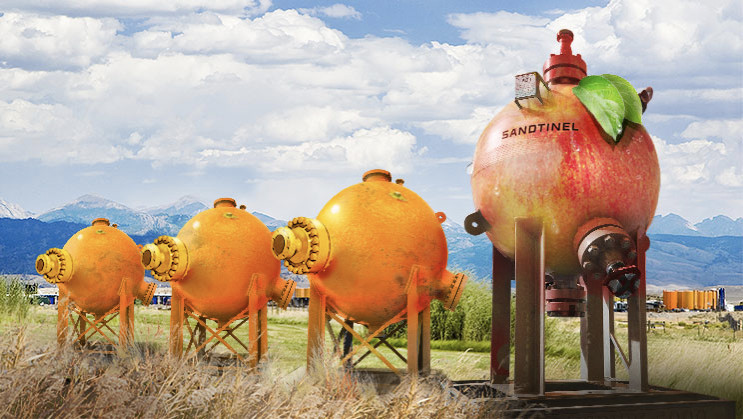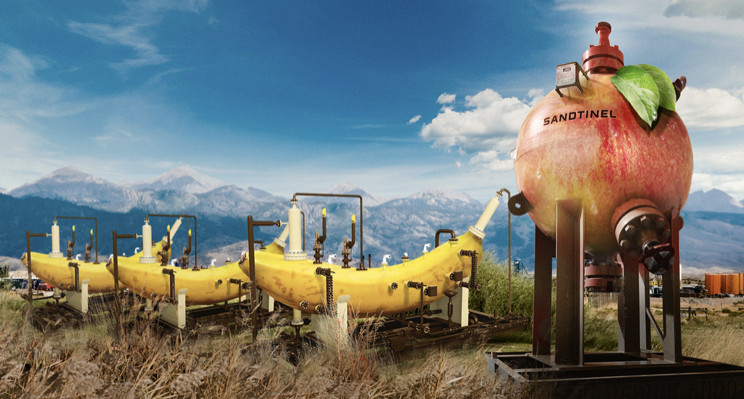
Question: What are the different types of sand separation technology currently available today?
Chris: There are several different kinds of sand separators out there. Traditionally the options have been an upright vertical cyclonic separator, a horizontal desander, a spherical baffle type separator, or a filter-based separator.
For the most part, these separators have been plagued with issues. Cyclonics turndown at low flow rates. Horizontal separators are a huge hassle to try to clean out. Baffle-type spheres have low storage capacity. These separators are less efficient than we would want producers to see, and are below the threshold of what we think the modern flowback environment demands.
When you use low efficiency sand separators you will require multiple units to try to capture the remainder which leads to problems of its own, like a very high back pressure on the well which reduces overall production.
Question: What makes Sandtinel technology different?
Chris: Sandtinel separators are unlike any you’ve seen before. They have the highest separation efficiency of any mechanical separator on the market. We target a minimum of 95% sand removal at a sand size of 100 mesh and larger – and we can prove it.
It’s common for our customers to remove all measurable sand from their lines, especially because Sandtinel separators do not experience turndown at low flow rates. They have a broad operating curve which allows them to defend your well across its entire lifespan. The units are simple to use and take only minutes to dump. They are safe, reliable, and see virtually no internal erosion or wear because of our Vapor Lock Technology.

"We’ve never had to take a unit out of service due to wear on the internals, which is a testament to both the technology and to our routine NDT program."
Question: How does the VL-TEK™ Vapor Lock Technology work?
Chris: The Vapor Lock Technology inside of a Sandtinel temporarily breaks apart a high velocity multiphase flow so that the gas can be segregated from the rest of the fluid. We’ve found that the gas phase is typically the main driver of the velocity of the flow – often 95% to 99% or more of the superficial velocity of the flow is due to the gas. But it’s typically the remaining 1% to 5% of the liquid which is carrying the sand in it as a slurry. By isolating and temporarily separating the gas from the system, we can slow the flow down and remove the sand very effectively from the liquid phase. The flow recombines at the outlet of the vessel so that from the outside, there is no interruption or change to your processes. We knock the sand into the bottom of the sphere, where the Sand Lock technology traps it prior to periodic dumping.
Question: There’s a lot of talk about how technology is essential to working towards emissions reduction. How does Sandtinel technology help?
Chris: Substantially reducing emissions requires a multi-pronged approach tackling many different parts of the problem. From the perspective of sand separation, what we’re usually talking about is the fugitive emissions released from the sand separator when it’s being dumped. When you’re dumping a large volume of sand slurry, you’re going to get some amount of gas and oil coming out at the same time. If you’re dumping to an open-top tank, as is pretty typical, then that gas is going to be released into the atmosphere. One of the benefits of the Vapor Lock design is that because we are isolating the gas away from the liquid, there is very little agitation of gas into the bottom of the vessel. We’ve estimated some pretty huge reduction in fugitive emissions compared to current technology like cyclones which depend on that agitation to achieve sand removal.
Question: The safety of the environment and people are a priority onsite. How are Sandtinel separators safer than other sand separation technology on the market?
Chris: The main benefit Sandtinel offers is avoiding exposure for operators by providing remote or automated dumping options. Sandtinel separators do not need to be opened up and cleaned out, serviced, or have elements changed out while in the field. They don’t contain sacrificial elements, interchangeable inserts, or filter mechanisms to clean. Instead, operating the unit is as simple as turning the valve at the bottom drain for a minute or two for each dump, not only saving the operator time during their day and reducing the downtime on the well, but also keeping them out of the red zone for longer. Our automated dump solution, the Sandtinel Dispatcher, is a single or multi-well autodump skid package that operates the separators remotely or on a timed basis. We take safety seriously and are always looking for ways to create smarter and safer technology to tackle new challenges in sand removal.
Question: What are some of the challenges that operators are facing in the field?
Chris: We’ve found that the modern flowback environment is becoming more challenging for sand removal and more demanding. There has definitely been a change in mindset to open wells as aggressively as possible, and operators and producers want sand separators that can keep up. If you need to throttle your well just to go through your sand separator, then that starts to become a business decision about how much erosion you can tolerate without a sand separator to maximize your production. Fundamentally, we don’t want a sand separator to be holding you back from getting the most you can out of your well.
Aside from that, we’ve also seen some shifts in mindsets in the last few years for the kind of sand which is being used, moving from the best possible frac sand to sand that can be easily sourced. A lot of this is sand that breaks down more easily (e.g. not resin coated). So the push has been for sand separators that can handle more of the small stuff, the fines, and which can do it at higher flow rates, higher gas rates, and tougher conditions. We believe the Sandtinel is the best overall solution for those needs.
Question: What kind of operation would benefit from using a Sandtinel separator?
Chris: Sandtinel separators have been used on a wide variety of operations, from initial drill-outs, all the way through to long-term production. We have a pretty wide fleet of equipment for different needs, including 10K spheres for high pressure operations, our G4 Maverick series for trouble wells, and our 96” Generals for group well applications. Our main goal is to make sure you have the right sand separator for the job. We never want you to have a sand separator you don’t need, and we always want to make sure the unit is providing value while it’s out on the job. We believe that data is king, and that collecting as much information from the field as possible will ensure you can make the operational decisions you need to use our equipment effectively.
Question: It’s not a secret that Sandtinel separators cost more than some other separators. Can you speak to the value of a Sandtinel?
Chris: Sandtinel spheres can cost more up-front, but customers are paying for over 10 years of experience and game-changing technology which not only replaces multiple pieces of existing equipment, but surpasses them. If you’re using traditional cyclonic separators, it doesn’t matter how many of them you put in a row off your well – you’re never going to be able to achieve the same level of efficiency you would get with a single Sandtinel. We’ve always tried to look at the big picture when it comes to the cost of equipment – the cost of not using a sand separator in damage to valves and chargeback; the cost of downtime and operator time when cleaning out equipment; the cost of lost production due to the high back pressure across a hydrocyclone. Sandtinel’s vortex separators are the top of the line when it comes to sand removal, and we have found that their substantial benefits pay for themselves many times over in protecting your well.

"If you’re using traditional cyclonic separators, it doesn’t matter how many of them you put in a row off your well – you’re never going to be able to achieve the same level of efficiency you would get with a single Sandtinel."
Question: As needs continue to evolve, what is Sandtinel doing to keep up and stay on the cutting edge of technology?
Chris: We have an R&D center of excellence which continuously works to develop new solutions to meet customer needs, like our automated Sandtinel Dispatcher. At the same time, we’re working on other cleaner, greener, smarter, and safer solutions to the problems we hear about every day. We support our equipment in the field with industry-leading fluid dynamics modeling, and are constantly working on new products to meet the challenges operators face.
This website is owned, operated, and maintained by Energera, referred to as "this website" in the following document.
This website respects the privacy of our employees, our suppliers and our clients and ensures that the personal information we collect remains secure and protected. There are times where personal information must be shared with an interested third party. In such circumstances, this website will not release any personal information without first advising of its intended use and obtaining the permission to do so from the affected individual.
We do not automatically gather any personal information from you, such as your name, phone number, email, or address. This information is only obtained if you supply it voluntarily, usually through contacting us via email or registering in a secure portion of the site. By choosing to provide us with your Personal Information, you are consenting to its use in accordance with the principles outlined in this Privacy Policy and as outlined at the time you are asked to provide any Personal Information.
Any personal information you do provide is managed according to the Alberta Freedom of Information and Protection of Privacy Act. This means that, at the point of collection, you will be informed that your personal information is being collected, the purpose for which it is being collected and that you have a right of access to the information.
Our policy is designed to meet or exceed the requirements of Canadian Federal and Provincial privacy laws. We constantly self-evaluate our practices and procedures to maintain the highest standard in this regard.
This website will make every effort to ensure personal information remains current and is updated internally and with third party suppliers in a timely manner. Individuals are expected to update this website with any changes to their personal information. The information will only be updated when required for the intended, previously described purposes.
Only employees who need the information to perform a specific job have access to personal information.
We have secure databases where we store data. We also may store your personal information in paper document files in our offices.
The processes of our business include sharing your personal information with others to carry out our placement services.
Email transmission can be accessed by other Internet users. If you want to keep certain information confidential you may contact us by telephone, in person, or via mail.
This website has set mandatory retention time limits based on Provincial Employment and Labour Standards and third-party suppliers are instructed to follow the same guidelines. Appropriate safeguards relevant to the sensitivity of the information will be employed.
This website will use your Personal Information to contact you for support purposes. If you wish to be removed from our contact database, please info@energera.com.
Like most web servers on the Internet, this website' servers maintain access logs that record web browser activity. These logs associate an Internet Protocol (IP) address with each request for content from the servers.
When you visit this web site, our web server automatically collects a limited amount of standard information essential to the operation and evaluation of the web site. This information includes:
This information helps us assess our information services and is used only for this purpose. It is collected in compliance with section 33 of the Freedom of Information and Protection of Privacy (FOIP) Act.
This information is collected in order to help make our site more useful to visitors, to learn about the number of visitors to our site, and to learn about the types of technology our visitors use. We do not track information about individuals and their visit. We will not identify users or their browsing activities, except as required by a law of Alberta or Canada or if we are compelled to produce this information for a legal proceeding.
For security purposes and to ensure that this service remains available to all users, this computer system employs software programs to monitor network traffic to identify unauthorized attempts to upload or change information, or otherwise cause damage.
Except for authorized law enforcement investigations, no other attempts are made to identify individual users or their usage habits.
Our web servers are able to use "cookie" technology to keep track of the web browsers with which they are communicating.
During a cookie transaction, a web server will hand a web browser some data prescribed by the web site's developers. The web browser will return that data with its next request for content
from the web site. Using this technology, it is possible for an application running on a web server to distinguish one web browser's activity from another.
This website' web servers will make use of such cookies when required to identify ongoing sessions with individual online visitors. Examples include:
In all cases, the cookie data this website' web servers may hand your browser contain only "session" identifying information. No other personal information is passed to your browser, where it may be stored on your own computer.
Cookie-related data is not permanently stored on this website' web servers. Information stored temporarily in our cookie collection never includes a visitor's name or address or sensitive data.
Further, this website does not match for its records any session-identifying cookie information with the Internet Protocol (IP) addresses described above in the information on monitoring Web-Site Traffic.
This website is committed to the security of personal information it may collect online or offline. This website has taken reasonable precautions to protect this personal information from loss, misuse or alteration. Any third parties who may have roles in managing such information on behalf of the this website are also committed to the same principles.
This website includes links to web pages or sites operated by third parties. We endeavor to make it clear that certain links will take you away from our site and to destinations over which we have no control.
Our public website privacy statement does not apply to the sites of third parties to which we link. Instead, we encourage you to review the policies of these sites yourself upon your arrival.
This website will release your personal information to you upon request, along with the use and disclosure of any personal information.
Specific requests for information can be directed to the Privacy Officer via info@energera.com. The information will be released within 30 days of receipt of the request. Should this website not be able to comply with the request, a justifiable reason will be given to the requestor. This website considers the following reasons justifiable reasons to refuse access to personal information.
This list is not exhaustive and other reasons may be considered justifiable.
You have the right to file a challenge about this website's compliance with Privacy legislation. This website will consider all requests seriously and will investigate any complaints thoroughly. To make a challenge please send all relevant details and specifics to this website's Privacy officer at info@energera.com.
This website will occasionally update this privacy statement. When we do, we will also revise the "last updated" date at the top of the privacy statement. For material changes to this statement, this website will notify you by placing prominent notice on the website.
For questions or comments regarding this public website privacy statement please contact us by email: info@energera.com.